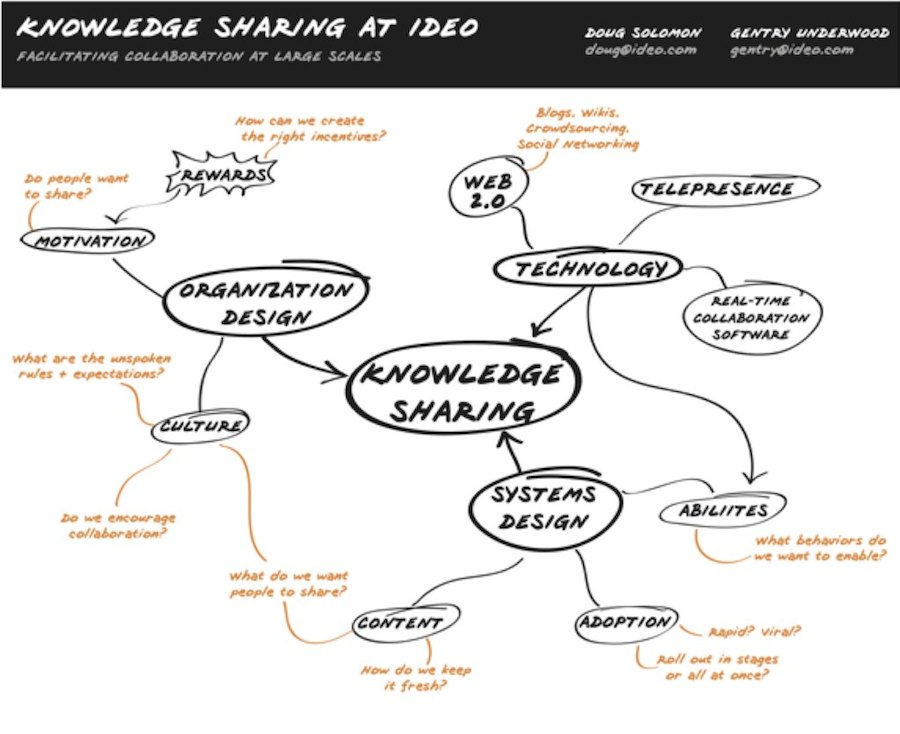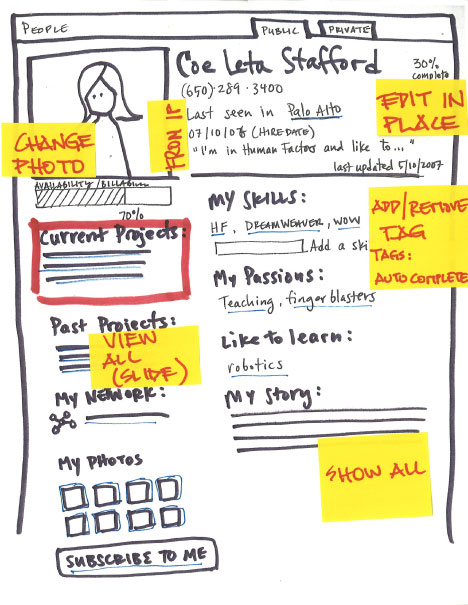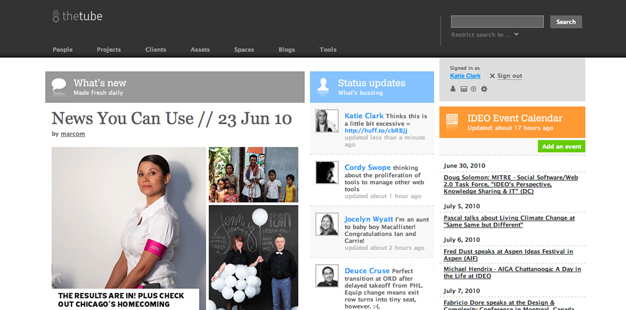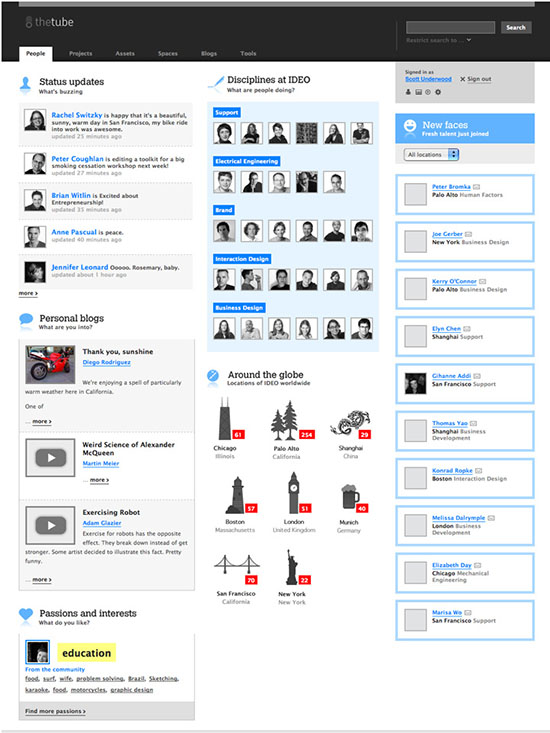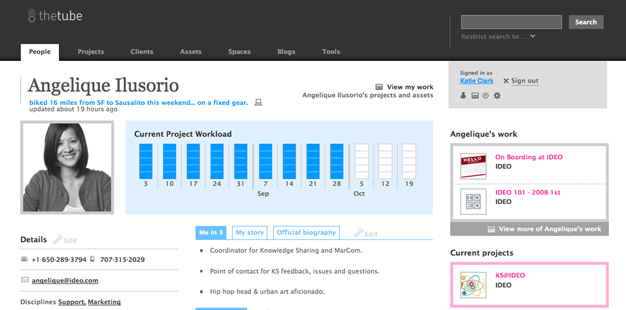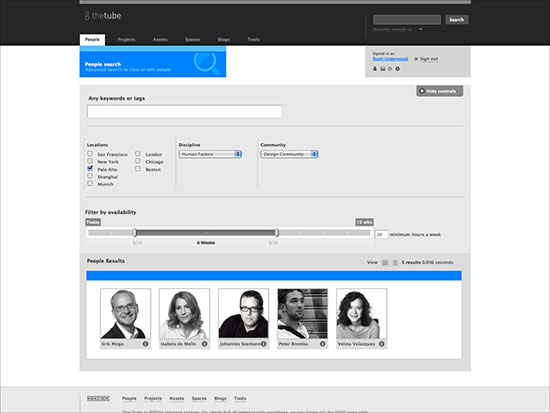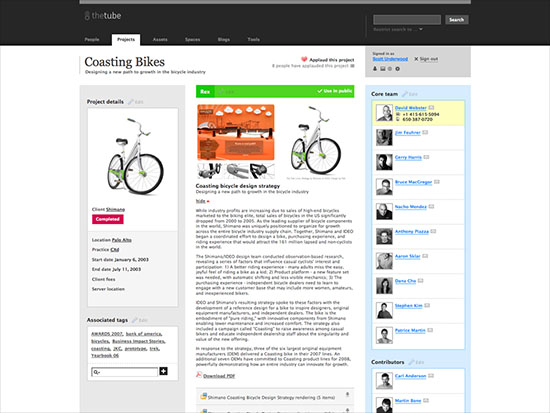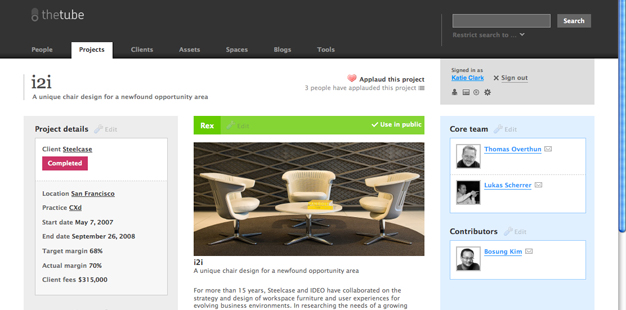The Tube (Intranet/wiki) Knowledge Sharing for Innovation @ IDEO
by gab on abril 2, 2014
Hace un tiempo IDEO se embarcó en crear una wiki / intranet interna para facilitar la colaboración, la innovación, compartir la información, asignar recursos y manejar proyectos.
– A partir de ese proyecto, destilaron las lecciones que aprendieron y se juntaron con una empresa de software para hacer una solución para otros.
http://www.ideo.com/work/spaces/
– El resultado es este software comercializado por MoxieSoft:
http://www.moxiesoft.com/products/products.aspx
Sumario
«To be successful and truly collaborative, knowledge-sharing systems require intuitive tools that connect people, reward participation, and align well with existing work and communication patterns. After IDEO’s two-year internal development effort to create and implement «the Tube,» their enterprise-wide intranet system, we gained new understanding and experience in balancing technology possibilities with behavior realities. The unique success of the Tube comes from the insight that effective knowledge sharing is a social activity that is enabled by technology, rather than a technological solution bolted onto an existing work culture. Now IDEO’s Knowledge Sharing Team shares a set of design principles for building online collaboration systems that really work.»
Lessons
«Design Principles: IDEO’s Knowledge Sharing Team synthesized their findings into five design principles that guided the creation of the Tube, and scale and adapt to inform similar efforts within other organizations.
1) Build Pointers to People: rather than trying to take all of the knowledge out of people’s heads and store it in a giant database, focus primarily on helping people to identify who they are — their passion, experience, and expertise — and connect people based on that information.
2) Build Rewarding Systems: a system that requires altruism is unlikely to be successful. Similarly, systems that require users to participate (e.g. compliance-based design) rarely get anything more than participation at the lowest required level. Effective knowledge sharing systems must simultaneously meet the needs of the organization while motivating individual participation. The Tube encourages individual participation in a number of ways, from establishing a platform to allow employees to showcase their best work, to integrating the salary range process and project resourcing process into the system.
3) Demand Intuitive Interfaces: intuitive interfaces are absolutely essential for social software because they facilitate viral adoption. The system must present as few points of friction as possible from the process of becoming an active user. For example, early wiki systems required users to set up an account the first time they wanted to add content, learn special wiki languages to format pages, and build not only the content but also the navigation to support it. These points of frustration discourage users from making the transition from consumers to contributors.
4) Take the Road More Traveled: if a tool requires people to go out of their way to use it, adoption will always be a challenge, no matter how wonderfully designed. Wherever possible, strive to integrate tools into existing work processes — bring the system to the user rather than the other way around. For example, the IDEO blogging system didn’t take off until the team added a program that sends digest emails with new content from the blogs each employee has subscribed to.
5) Iterate Early and Often: building effective systems for organizations means designing tools and workflows that mirror the social systems they are meant to support. This happens through lots of iterative design, beginning with rough in situ prototypes (paper-based or hacked existing systems) and evolving into working systems that can be tested broadly throughout the organization. This process doesn’t end with «launch» either. Knowledge sharing systems should grow with the organization they support, and in turn they shape the organization by enabling new levels of collaboration. Thus these systems and the designers creating them should think of them as an ongoing, evolving dialog with the employees using them. At IDEO, the team pushes out revisions to the Tube (both bug fixes and new features) each Thursday. Much as Google keeps all of its software in “beta” for as long as possible, this reinforce the notion that the Tube is a working prototype and set the expectation for ongoing change, which enhances our user experience without confusing it. When individual passion meets collaborative tools that fit into the flow of one’s worklife, powerful innovations can result. IDEO’s goal is to continue to build a platform for innovation that builds on the passions and cooperative foundations of our culture. As is a tradition at IDEO, the team will continue to share with the outside world what they learn along the way.»
Más Información:
– Un resumen del proyecto hecho por los líderes del mismo:
http://www.managementexchange.com/story/tube-ideo-builds-collaboration-system-inspires-through-passion, está como PDF.
– Un comentario del proyecto, hecho por terceros:
http://www.steptwo.com.au/papers/kmc_socialstaffdirectories/index.html
Imágenes
Comentarios adicionales:
– Búsqueda
We have a few ways to search:
1. an overall system search
2. a way to limit that search to various types of pages
3. a way to search only tags that people have put on pages
4. some custom search screens that are interactive and allow users to search, for example, for people with certain skiils, interests, and time availability.
– Plataforma sobre la que se armó
Mix de cosas opensource, mezcladas. Basado en Ruby on Rails, con blogs, wiki y espacios personales.
